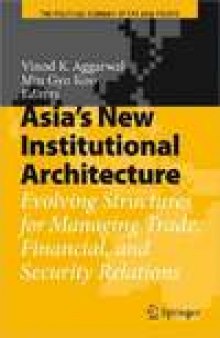 جزییات کتاب
جزییات کتاب
This book investigates the origins and evolution of Asia’s new institutional architecture in trade, finance, and security from both a theoretical and empirical perspective. The traditional institutional equilibrium in Asia has come under heavy strain in the "post triple shocks period" - the post-Cold War, the post-financial crisis of 1997-98, and the post-9-11 attacks. The new dynamics of rivalry and cooperation among states at both the intraregional and transregional levels is now shaping a new institutional architecture. Political and business leaders from Northeast and Southeast Asia interact with each other more frequently. South Asia’s participation in the rest of Asia in recent years is truly impressive. As we show, the future institutional trajectory of Asia is still open, but we believe that the book provides a timely examination of key shifts in the region. In doing so, our hope is to provide policymakers and analysts with an institutional road map for the future.The first comparative systematic study of Asia’s emerging economic and security architecture. Via a series of theoretically sophisticated, yet empirically rich studies of Asia´s contemporary regional economic and security structures, Aggarwal, Koo and their colleagues, using an institutional bargaining approach, provide a template for the analysis of a most important set of evolving international relationships. This volume, while measured in its conclusions and sensitive to the problematic nature of Asian cooperation, nevertheless leaves us in little doubt as to both the theoretical and policy significance of the regional institutional endeavours in train in the early 21st century.Richard Higgott, University of WarwickThis volume offers a fresh and analytically rigorous perspective on the changing role of Asia's regional institutions since the end of the Cold War. Offering valuable insights into their design and function, this book challenges the conventional wisdom that regional institutions play a marginal role in Asia's economic and security architecture. The publication of this volume is a testimony to the increasing theoretical sophistication and empirical richness of the study of Asian regionalism as a field of scholarly inquiry in its own right. Amitav Acharya, University of Bristol



 دانلود کتاب
دانلود کتاب

 جزییات کتاب
جزییات کتاب



 این کتاب رو مطالعه کردید؟ نظر شما چیست؟
این کتاب رو مطالعه کردید؟ نظر شما چیست؟
